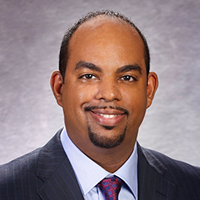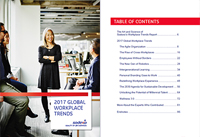A new sustainable approach to wellness
Interview with Nebeyou Abebe, Senior Director of Health & Well-being at Sodexo.
 Sodexo’s 2017 Workplace Trends Report is fresh off the presses with ten major trends that will impact our workplace today and in the years to come. Today we sat down with Nebeyou Abebe, Senior Director of Health & Well-being at Sodexo, to talk about the evolution of wellness in the workplace.
Sodexo’s 2017 Workplace Trends Report is fresh off the presses with ten major trends that will impact our workplace today and in the years to come. Today we sat down with Nebeyou Abebe, Senior Director of Health & Well-being at Sodexo, to talk about the evolution of wellness in the workplace.
What is your take on wellness in the workplace today?
Nebeyou Abebe: Employers, large and small, and across all industries, are continuously evolving their health and wellness strategies to improve upon their programmatic outcomes. Changing human behavior is not an easy task. Some companies are making adequate financial investments and have the right personnel in place to design a comprehensive program that will achieve desired outcomes, while other companies continue to struggle for many different reasons. The conventional way of thinking about work and wellness is not sustainable. While improving employees’ physical health is important, more organizations are beginning to take a more holistic approach by also focusing on the emotional, mental, spiritual and financial health of their workforce. With that said, building a culture of health in the workplace is paramount and should be the primary focus of any wellness program. In my view, having a comprehensive strategy that is rooted in science, employee-centric, and leverages technology is the key to success.
Why is the shift to comprehensive wellness so important?
N.A.: According to Rand Corporation, only 13 percent of workplace wellness programs are comprehensive in nature, which is why many organizations are not realizing a significant ROI. A shift to comprehensive wellness takes a whole person approach and addresses all things that are stressors in an employee’s life. There is evidence showing that a comprehensive approach to wellness leads to higher levels of employee satisfaction, engagement and productivity. To really engage employees, employers need to provide the right balance of resources, programs, tools, and technology to enable employees to own and manage their health and well-being. Additionally, given the amount of time employees are beginning to spend away from work due to new telework and flexible work policies, it is extremely important for wellness programs to transcend the boundaries of the workplace. This is where technology can help an employer continuously engage their employees regardless of whether they are at work, at home, or on the road.
What benefits can employers expect to see as a result of a comprehensive strategy?
N.A.: When a wellness program truly supports a higher overall quality of life for the employee, there are so many benefits – from having a more engaged workforce, greater productivity, higher rates of employee satisfaction, greater employee retention. Wellness programs can even help a company position itself as an employer of choice which can reduce attrition and help attract the best talent.
We hear a lot about the impacts of the built environment. What role does it play in wellness?
N.A.: I recently came across a study conducted by the Harvard School of Public Health that included 109 workers at 10 buildings in five cities across the United States. They discovered that working in green certified buildings is associated with higher cognitive function scores, fewer sick building symptoms and higher sleep quality scores. So, in my view, establishing a healthy built environment should be part of an organization’s wellness strategy given the positive health impact it can have on the workforce.
What does wellness look like with a Sodexo lens?
N.A.: We surveyed our clients last year and asked them what they need to take their wellness programs to the next level. And it’s quite simple, clients want innovation and best practices. They want more effective ways to engage with their employees to help them achieve their personal health and wellness goals and live a high quality of life. At Sodexo, we pride ourselves on being the global leader in Quality of Life services, and we have already conducted a significant amount of research to help us define what that means. Given our subject matter expertise in nutrition, health and wellness, and our ability to form strategic partnerships with clients and key stakeholders, we can design comprehensive workforce wellness solutions that deliver positive results. We are thinking outside the box to find new ways to leverage our existing health and wellness programs and services to help our clients (and ourselves) achieve their desired goals. That is our focus moving forward and that is what the company is investing in.



